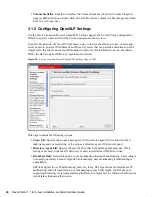
10
Novell Client 1.1 for Linux Installation and Administration Guide
no
vd
ocx
(E
NU)
9 Decem
ber
200
5
• The Novell Client for Linux uses OpenSLP, whereas the Novell Client for Windows uses
Novell's implementation of SLP. The network administrator
must
set up OpenSLP before users
can look up trees, contexts, and servers using the Browse buttons in the Novell Client Login
window. If OpenSLP is not set up, the user must enter a username, tree, and context to connect
to the network. See
Chapter 4, “Managing Login,” on page 27
for more information.
Because Linux uses OpenSLP, the implementation is different and the user's experience is
different. For more information, see
Section 4.3, “Using OpenSLP to Simplify Login,” on
page 28
.
• The Novell Client for Linux does not use the Dynamic Local User or Location Profiles that are
available in Windows.
User Interface
Both a graphical user interface and command line utilities are available to complete client actions
such as mapping drives, setting trustee rights, and copying files.
Login Scripts
Novell has been able to port the vast majority of login script functionality to the Linux platform.
This means that the login scripts you create in your network work for both Windows users and
Linux users with very little difference in functionality.
Some difference do exist, however. For example, mapped drives are implemented by creating
symbolic links and search drives are not available on Linux. Other small differences are created by
the inherent difference between Windows and Linux. All the differences and issues are listed in the
Novell Login Scripts Guide
.
1.2 Understanding the Novell Client for Linux
Virtual File System
The Novell Client for Linux differs from previous Novell Clients to enable it to work on the Linux
platform. In Windows, the Novell Client loads a single binary that works on multiple operating
system platforms without modifications. The Novell Client for Linux has a Virtual File System that
consists of a kernel module (
novfs.ko
) that runs as part of the Linux kernel and a daemon
(
novfsd
) that runs in the user space. Both components must be running on the workstation for the
client to connect to the network.
The daemon can run on any of the
supported Linux platforms
without modification. The kernel
module, however, is dependent on the kernel version and must be compiled to match the kernel on
the workstation. When the Novell Client is installed, it compiles the kernel module during the
installation process. If this process fails, the kernel module cannot load. It attempts to recompile
when the workstation is restarted.
1.2.1 Understanding When the Virtual File System Kernel
Module Needs to Be Compiled
The following is a list of the instances when you must compile the Novell Client Virtual File System
Kernel Module (
novfs.ko
):
• You installed the Novell Client and received an error message. This generally occurs because
all the required packages are not installed on a workstation. You must install these packages,
Содержание CLIENT FOR LINUX 1.1
Страница 4: ......
Страница 8: ...8 Novell Client 1 1 for Linux Installation and Administration Guide...
Страница 12: ...12 Novell Client 1 1 for Linux Installation and Administration Guide...
Страница 18: ...18 Novell Client 1 1 for Linux Installation and Administration Guide...
Страница 30: ...30 Novell Client 1 1 for Linux Installation and Administration Guide...
Страница 36: ...36 Novell Client 1 1 for Linux Installation and Administration Guide...
Страница 40: ...40 Novell Client 1 1 for Linux Installation and Administration Guide...
Страница 44: ...44 Novell Client 1 1 for Linux Installation and Administration Guide...
Страница 46: ...46 Novell Client 1 1 for Linux Installation and Administration Guide...











































